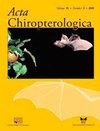Barbastelles in a Production Landscape: Where Do They Roost?
IF 0.7
4区 生物学
Q4 ZOOLOGY
引用次数: 4
Abstract
Extensive areas of old forests have declined all over the temperate regions of Europe mainly due to extensive forestry. This is likely to have negative impact on bats that roost in trees, such as the western barbastelle Barbastella barbastellus. We investigated its selection of summer roosts in a commercially used landscape in southern Sweden. We captured and radio-tracked 14 bats and found 17 occupied roosts. Nine of the roosts, including two used by a maternity colony (ca. 30 females), were located between overlapping boards on the gables of barns. The remaining eight roosts, all used by single individuals, were under lose bark on thin trees (DBH = 0.2–0.35 m). All recorded roosts had entrances pointing downwards, were adjacent to deciduous trees providing protective darkness, and were in areas without artificial lighting. In the barns, the bats avoided the northern aspect, which is the lightest (sun sets in the NW and rises in the NE). Roost temperatures did not differ between tree- and barn roosts. Average ambient light intensity on emergence and return was 13.3 lux (SD = 10.1 lux). Roosts in trees and barns shared common physical characteristics, yet despite this both maternity roosts were located in barns, perhaps because such roosts had more space than available tree roosts. Our results suggest that in areas deprived of large trees and extensive old forest, barbastelle shows flexibility in roost selection, although they consistently avoid artificial lights of all kinds. An abundance of potential roosts in trees and buildings and absence of light pollution are therefore key elements in a holistic conservation program for this species.生产环境中的野蛮人:它们在哪里栖息?
欧洲温带地区大片的古老森林面积减少,这主要是由于广泛的林业。这可能会对栖息在树上的蝙蝠产生负面影响,比如西部的barbastelle Barbastella barbastellus。我们调查了它在瑞典南部一处商业景观中的夏季栖息地选择。我们捕获并用无线电追踪了14只蝙蝠,发现了17个被占领的栖息地。其中九个栖息地,包括一个母鸟群落使用的两个栖息地(约30只雌性),位于谷仓山墙上重叠的木板之间。剩下的八个栖息地都是由单个个体使用的,位于薄树上的树皮下(DBH=0.2-0.35米)。所有记录在案的栖息地都有指向下方的入口,靠近落叶树,提供保护性的黑暗,并且位于没有人工照明的区域。在谷仓里,蝙蝠避开了最轻的北侧(太阳从西北落下,从东北升起)。树栖和谷仓栖的公鸡温度没有差异。出现和返回时的平均环境光强度为13.3勒克斯(SD=10.1勒克斯)。树上和谷仓里的鸡有着共同的身体特征,尽管如此,这两个母鸡的栖息地都位于谷仓里,也许是因为这样的栖息地比可用的树上栖息地有更多的空间。我们的研究结果表明,在没有大树和大片老林的地区,barbastelle在栖息地选择方面表现出灵活性,尽管它们一直避免使用各种人造光。因此,树木和建筑物中有大量的潜在栖息地,没有光污染,是该物种整体保护计划的关键要素。
本文章由计算机程序翻译,如有差异,请以英文原文为准。
求助全文
约1分钟内获得全文
求助全文
来源期刊

Acta Chiropterologica
生物-动物学
CiteScore
2.50
自引率
20.00%
发文量
42
审稿时长
>12 weeks
期刊介绍:
Acta Chiropterologica, published by the Museum and Institute of Zoology at the Polish Academy of Sciences, is devoted solely to the study and discussion of bats.
 求助内容:
求助内容: 应助结果提醒方式:
应助结果提醒方式:


